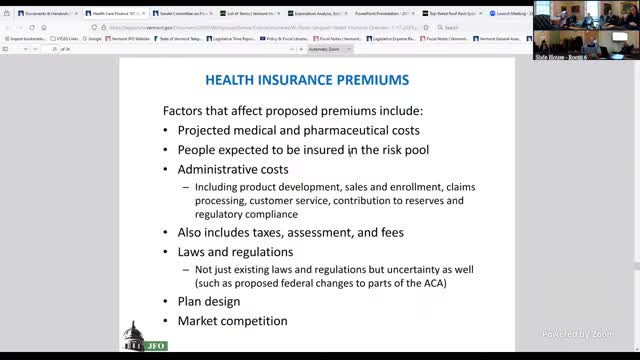Vermont health insurers face scrutiny as Blue Cross Blue Shield dominates market share
January 18, 2025 | Finance, SENATE, Committees, Legislative , Vermont
This article was created by AI summarizing key points discussed. AI makes mistakes, so for full details and context, please refer to the video of the full meeting. Please report any errors so we can fix them. Report an error »

In a recent meeting of the Vermont Senate Finance Committee, discussions centered around the complexities of health insurance premiums and the regulatory landscape governing them. The atmosphere was charged with the urgency of understanding how various factors influence the costs that consumers face.
One of the key topics was the breakdown of health insurance premiums, which encompass a range of administrative costs, claims processing, and customer service. The committee highlighted the importance of maintaining competitive premiums, as insurers must balance their rates against market competition to avoid losing customers. A chart presented during the meeting illustrated the national averages for premium allocations, revealing that a significant portion goes towards administrative expenses and prescription drugs.
A critical point of discussion was the medical loss ratio, a measure mandated by the Affordable Care Act that requires insurers to spend at least 80% of premium income on healthcare claims and quality improvements. Insurers exceeding this threshold must refund the excess to consumers, ensuring that a substantial portion of premium dollars directly benefits policyholders. Blue Cross Blue Shield, Vermont's largest health insurer, was noted for its high medical loss ratio, indicating a commitment to spending more on claims than on profits.
The committee also examined the market share of health insurers in Vermont, with Blue Cross Blue Shield holding a dominant position at 60-70%, followed by MVP at around 35%. This concentration raises questions about competition and consumer choice in the state's health insurance market.
Regulatory oversight was another focal point, with the Green Mountain Care Board responsible for reviewing health insurance rates and ensuring the solvency of insurers. The process involves public hearings and opportunities for consumer advocates to challenge insurers' assumptions, fostering transparency in the rate-setting process.
As the meeting concluded, the committee underscored the importance of these discussions in shaping the future of healthcare affordability in Vermont. With ongoing scrutiny of insurance practices and a commitment to consumer protection, the path forward remains critical for both policymakers and residents alike.
One of the key topics was the breakdown of health insurance premiums, which encompass a range of administrative costs, claims processing, and customer service. The committee highlighted the importance of maintaining competitive premiums, as insurers must balance their rates against market competition to avoid losing customers. A chart presented during the meeting illustrated the national averages for premium allocations, revealing that a significant portion goes towards administrative expenses and prescription drugs.
A critical point of discussion was the medical loss ratio, a measure mandated by the Affordable Care Act that requires insurers to spend at least 80% of premium income on healthcare claims and quality improvements. Insurers exceeding this threshold must refund the excess to consumers, ensuring that a substantial portion of premium dollars directly benefits policyholders. Blue Cross Blue Shield, Vermont's largest health insurer, was noted for its high medical loss ratio, indicating a commitment to spending more on claims than on profits.
The committee also examined the market share of health insurers in Vermont, with Blue Cross Blue Shield holding a dominant position at 60-70%, followed by MVP at around 35%. This concentration raises questions about competition and consumer choice in the state's health insurance market.
Regulatory oversight was another focal point, with the Green Mountain Care Board responsible for reviewing health insurance rates and ensuring the solvency of insurers. The process involves public hearings and opportunities for consumer advocates to challenge insurers' assumptions, fostering transparency in the rate-setting process.
As the meeting concluded, the committee underscored the importance of these discussions in shaping the future of healthcare affordability in Vermont. With ongoing scrutiny of insurance practices and a commitment to consumer protection, the path forward remains critical for both policymakers and residents alike.
View full meeting
This article is based on a recent meeting—watch the full video and explore the complete transcript for deeper insights into the discussion.
View full meeting